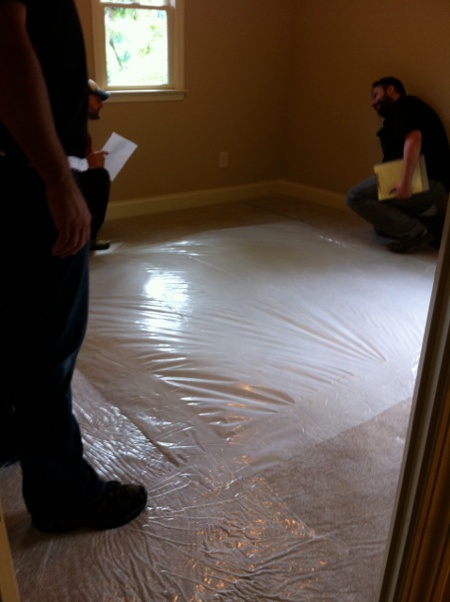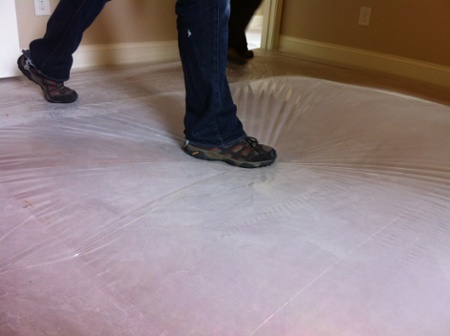A Fun Visualization of Air Leakage During a Blower Door Test

In our last home energy rater (HERS) training class, we saw something very interesting on one of our field visits. We were doing a Blower Door test on a new house, and one of the bedrooms upstairs had plastic taped over the carpet to protect it from dirt. The photo below shows what happened.
The plastic inflated like a balloon! This was a moderately airtight house, too. It passed the Georgia energy code requirement of 7 ACH50, but there was still enough air leaking in to do this. Where’s the air leakage coming from? We didn’t look for the source there, but I imagine the band joist was responsible for a lot of it since this was a second floor bedroom.
I’ve seen this happen before, too. The first time was in 2004, and I had my Blower Door set up in the kitchen of a little house. When I turned it on, the vinyl floor in the kitchen came up, and it felt like I was walking on a big pillow. Unfortunately, the builder wasn’t there to see the result of the bypass he left when he didn’t block and airseal the floor joists that ran across the wall between the garage and the finished basement, right below the kitchen.
Anyway, here’s my idea of how you could use this to your advantage. If you have kids and are thinking about renting one of those big inflatable space walk bouncy thingies, just cover one of your floors with plastic like this and depressurize your house. Voilà! You’re in business, and the kids are happy.

Hey, this could be a way to put that old whole-house fan to use, too!
Happy Friday!
This Post Has 10 Comments
Comments are closed.

This happened in most every
This happened in most every mobile home I monitored in the WX Program. I stopped the test may times for fear that the vinyl would be damaged! I was never really sure where this was coming from in a doublewide…the center seam between the two halves maybe?
This is always fun to show
This is always fun to show off to the owner/builder. I had a cool one recently with an impeccably installed crawlspace vapor barrier. The VB lifted up about 18 inches off the dirt, but virtually no air was getting through.
This is also a great one to
This is also a great one to show homeowners who paid a little extra for the “100%” glue-down option on their new kitchen vinyl.
sole plate of walls not
sole plate of walls not sealed to subfloor.
air leaks under sole plate. to caulk or use sill seal stops this leakage.
in homes on slabs the sheetrock leaves dust trails on hardwood or ceramic tile floors. if carpet then the air is filtered thru carpet.
when hvac folk talk about ghosting from candles it is this leakage site (sole plate) and the room going negative. not candles. dirt is filtered thru carpet leaving dirt trail usually due to lack of return air. usually master bedroom suites with 2 supplies in bedroom, supplies in closets and master bath. door undercut 1″ is insufficient for return of 5+ supplies.
The above comment makes a
The above comment makes a good observation about master bedroom suites without a return. My own airflow was measured at 1450 CFM total, of which 680 CFM was behind the bedroom door without any return provision in the original house. I made sure there was a return path added.
What’s odd is that the
What’s odd is that the plastic balloons only in one section of the floor. Does this mean that there is a hole in the floor/carpet under that section of the floor that connects to outside? Or could pressurized air be trapped only in that section of the floor? If the latter, ballooning means only that the room is depressurized relative to the trapped air, not that there is a leak in the building envelope.
David
David,
David,
Look closely at the picture, the plastic that is not lifting seems to be a perimeter lay-down of the sticky-backed plastic used for protecting stairs and walk paths.. The lifting center is simply a piece of standard plastic. I believe that accounts for what we see and does not indicate segmented pressurization.
John
Allison,
Allison,
I had a problem getting the ACH down in a two story home on a crawl space that had carpet and wood in the kitchen on a weatherization project.
The plastic billowed up like the picture.
We had rim joists issues on the second floor system.
After 27 years of running framing crews and understanding if you run 48 inches of subfloor adhesive at each run of plywood and use your 2×4 bumper stick to drive the t&g; closed, you will quickly get adhesive all over your bumper stick and your hands every time you pick it up and move it to the next piece. the solution to this problem is to run a 40 to 44 inch run of adhesive and it will not squirt out from under the plywood when you lay it, or get glue all over your hands.
There is a tremendous amount of air moving through the t&g; of each piece of plywood under the carpet.
Crawl space or floor system encapsulation is about the only way to cure it that I could figure out.
Any ideas?
Thanks,
Gene Wilhoit
Very interesting, I have not
Very interesting, I have not seen this captured on camera before. Thanks
Very interesting, I have not
Very interesting, I have not seen this captured on camera before. Thanks